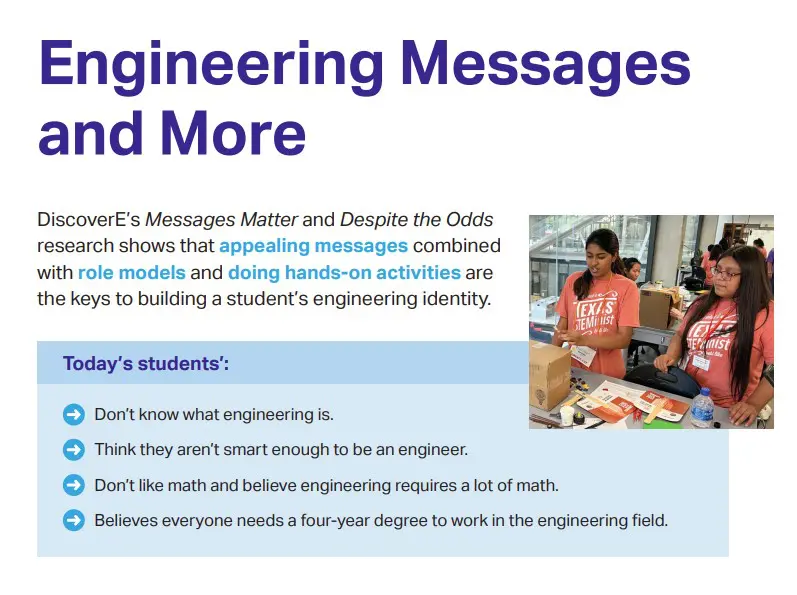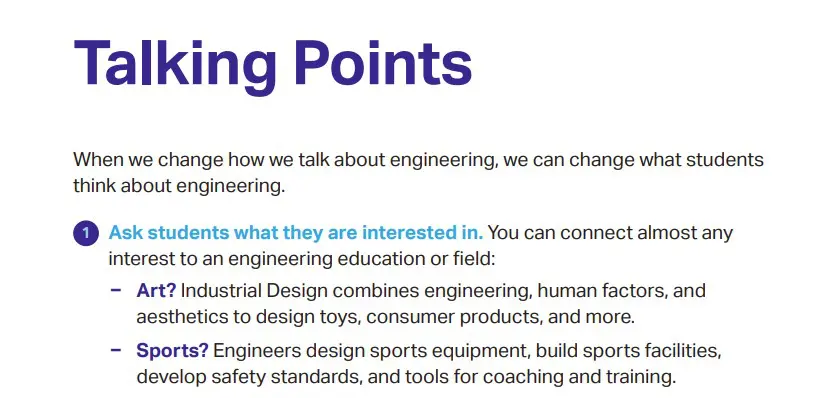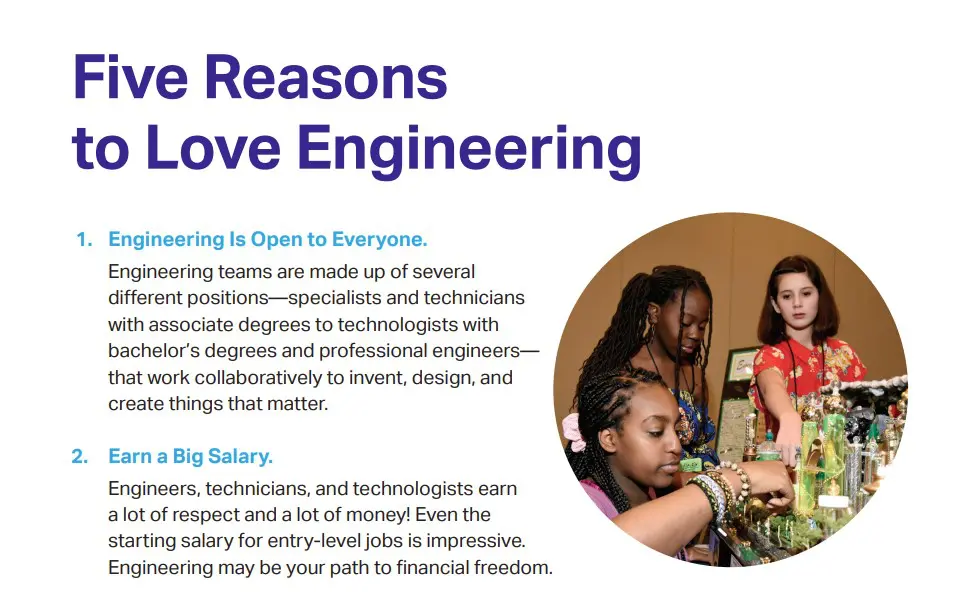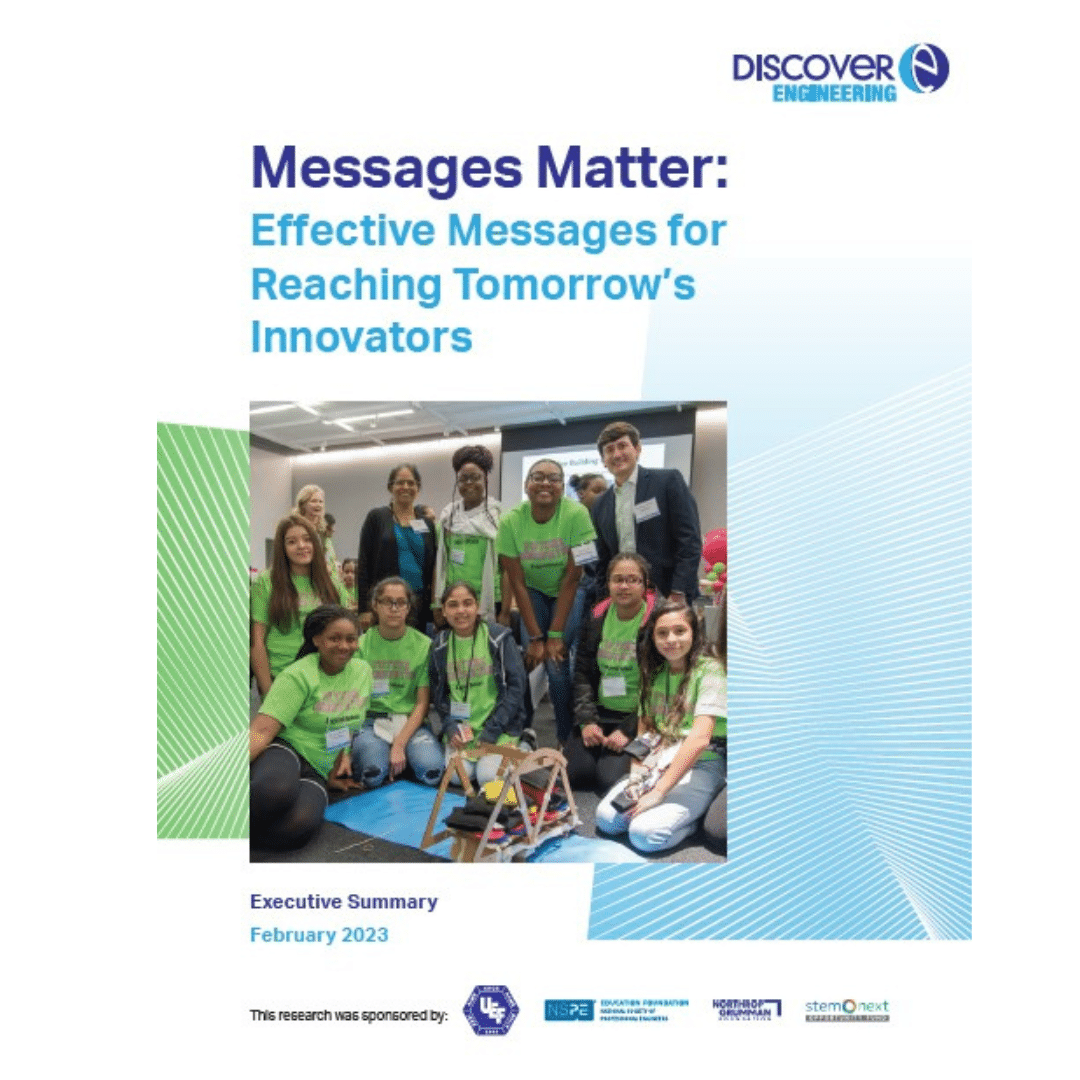Step 1
Engineering messages to share
Step 2
Engineering design process
Step 3
Leading STEM activities
Step 4
Be a role model
Engineering messages to share

Research shows when we share how engineering:
- Makes a difference in people’s lives
- Is creative
- Requires teamwork
We spark girls and boys interest in the field.
Incorporating these messages into how we talk about engineering to students and adults is critical because when we change how we talk about engineering, we can change what people think about engineering.
Making a difference with engineering
Imagine what life would be like without pollution controls to preserve the environment, life-saving medical equipment, or low-cost building materials for fighting global poverty. All this takes engineering. In very real and concrete ways, engineers save lives, prevent disease, and protect our planet.
Yet, this work is largely invisible to most people. It’s up to us to share how engineering and technology makes a difference and name what we do engineering.
Messages in action
Tips for talking about making a difference
- Connect engineering to helping people. When you describe your work, share more than what you do (e.g., I design satellites). Talk about how your work benefits people or society in general (e.g., I design satellites that help detect drought or are used to predict the weather).
- Not sure how to connect your job to a larger message of making a difference? Ask around for projects your company or industry may be working on that you can talk about.
- Check yourself for engineering jargon. Tip: think about how you’d tell a 3rd grader what you do.
Creativity in engineering and technology
Engineering is a great outlet for the imagination—behind every innovative idea is an engineer. Engineering requires an ability to think outside the box and visualize a number of different solutions and scenarios. Why then, don’t many people relate creativity and imagination to engineering?
It’s because we don’t talk about it! Too often engineers and technical professionals downplay the creative aspects of their work. But it’s a critical aspect of engineering and tech and a compelling message to share with students.
Messages in action
Tips for talking about making a difference
- Think about examples of creativity in your work. Have you solved a problem with an out of the box solution? Or is your organization doing something cutting edge or interesting that’s pushing the envelope in some manner?
- Creativity isn’t always about the output and often about process. The engineer design process and design thinking requires critical analysis and a willingness to look for new approaches. Do you have an example of how your team or organization uses creative thinking?
Engineering teamwork
Engineering takes teamwork, and engineers work with all kinds of people inside and outside the field. Yet lots of people have an image of engineers and technical professionals working alone solving math problems or writing code.
You know this isn’t accurate. It’s up to us to share with students how important teamwork is to getting the job done.
Tips for talking about engineering and teamwork
- Show don’t tell. A great way to illustrate teamwork is to co-present with a friend or colleague when visiting a classroom or afterschool, leading an activity, or talking to students about STEM careers.
- Prepare some examples. Do you have a good story about how a team came together to solve a problem or a colleague helped you out?
- Emphasize how your work requires sharing information and advancements across teams. Traditional schooling tests students on their individual knowledge. Even when they are working in teams, students can get caught up in the idea that sharing their ideas across teams is cheating or stealing.
Final thoughts
Because most kids don’t know any engineers or technicians and they don’t really know what engineers do, it’s important for us to talk to them and share what we do. As you think about making a difference, creativity, and teamwork, here are a few more engineering messages to share:
- Curiosity—Engineers ask lots of questions that start with: Why? How? What if? What are some of your go-to questions?
- Opportunities—An engineering degree offers lots of freedom in finding a person’s dream job. It can be a launching pad for jobs in business, design, medicine, law, and government. To employers or graduate schools, an engineering degree reflects a well-educated individual who has been taught ways of analyzing and solving problems that can lead to success in all kinds of fields.
Tips for engineering messages to share
- Pick one or two messages to share. We presented five messages here. That’s a lot. As you plan a classroom visit or career presentation, think about the age of the students, the amount of time you have, and what else you’ll be doing. How can you weave the messages into leading a hands-on activity. Do you have examples or stories that underscore teamwork, creativity or opportunities? Focus on those.
- Focus on engineering outputs. A lot of kids (and their parents) think engineers have to be straight A students to be a successful engineer. Rather than talk about what course requirements students need, talk about the rewards of being an engineer and the impact you have.




